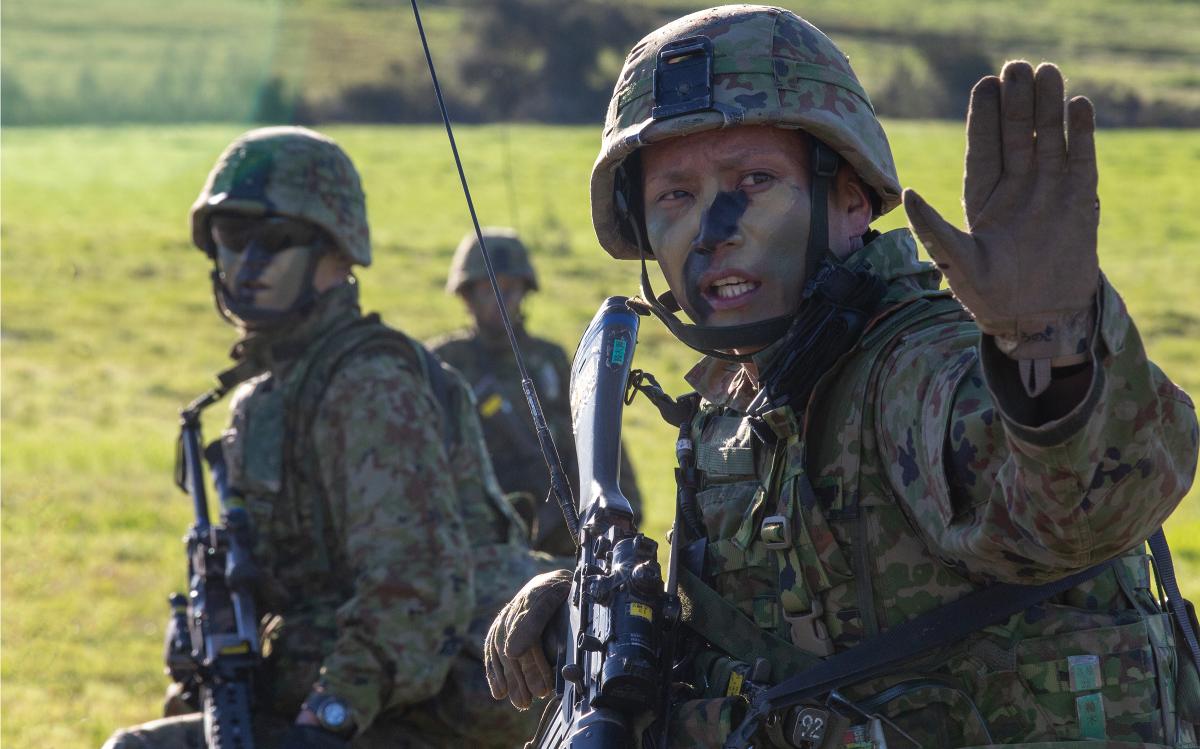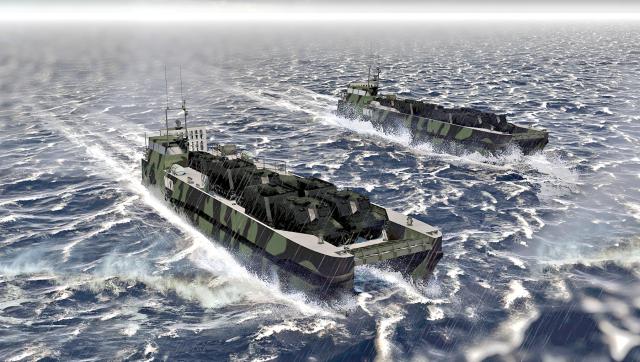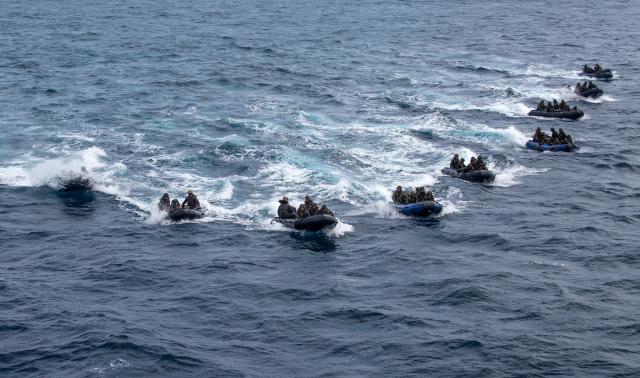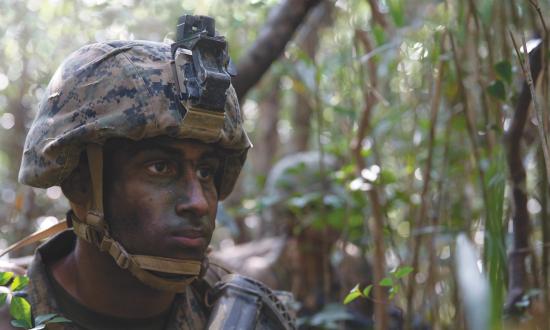Japan’s Southwest Islands are an archipelago between the Japanese mainland and Taiwan. The total length of the Southwest Islands is about 1,200 kilometers (km) (650 nautical miles [nm]), and there are about 200 islands in the chain. The islands form the boundary between the East China Sea and the Pacific Ocean and create chokepoints for People’s Liberation Army Navy (PLAN) force projection into the western Pacific to compete with the United States. Moreover, the distance between the Chinese mainland and the islands ranges from only 400 to 800 km (220 to 430 nm). This is relatively short from the perspective of modern military technology. These geographical, military, and technological features make this archipelago strategically critical to the region.
The Islands’ Strategic Importance
China considers the Southwest Islands part of the so-called first island chain. If China were to exercise its long-asserted right to forcibly unify Taiwan with the mainland, the PLA could expand its antiaccess/area-denial (A2/AD) threat from naval and air assets to U.S. forces deep into the western Pacific. Its reach would be even greater if it were to occupy and control parts of the Southwest Islands.
But if Japan and the United States keep the island chain secure, the PLA’s naval and air assets will have difficulty reaching so far. The PLA would be forced to change its path of advance from the island chain to a southern route, passing through the Luzon Strait and by the Philippines. China would need to quickly reconfigure its A2/AD capabilities to ensure control of Taiwan. Therefore, the Southwest Islands are key strategic terrain for Japan, the United States, and China.
China has declared interests in the Southwest Islands. China Coast Guard patrol vessels regularly intrude into Japanese territorial waters around the uninhabited Senkaku Islands at the western end of the chain, claiming them as Chinese territory. Moreover, hundreds of Chinese fishing boats surge around the Senkakus on occasion. If Chinese government officials or fishermen were to land and remain there, confrontation between Japanese and Chinese law enforcement agencies would lead to increased tensions. If Chinese leaders were instead to land PLA forces, Japanese and U.S. leaders might face the difficult choice of having to escalate to restore the status quo ante.1 Therefore, deterring China’s challenge and defending the Southwest Islands is a clear and urgent issue for Japan and the United States.
The Defense Posture
Until recently, the islands’ defense posture has been focused on Okinawa Island, the biggest island in the chain. The Japan Ground Self-Defense Force (JGSDF) has long deployed an infantry brigade and air-defense units there. Fighter wings of the Japan Air Self-Defense Force (JASDF) also are based on Okinawa. The United States has deployed Marine Corps units to Okinawa and maintains Kadena Air Base there. Recognition of the strategic importance of the Southwest Islands has led Japan to begin deploying JGSDF troops, including antiship and antiair missiles, to Amami Ōshima Island, Miyakojima Island, and Ishigakijima Island. The JASDF also has increased F-15 fighter aircraft deployments to Okinawa.
The Japan Self-Defense Forces (JSDF) recognizes the potential risk of a PLA invasion and occupation of parts of the region. In response, the JGSDF established in 2018 its first marine unit, the Amphibious Rapid Deployment Brigade (ARDB). The ARDB’s most important mission is amphibious assault to recover islands in the case of invasion. The ARDB consists of two amphibious rapid deployment regiments (light infantry), one combat landing battalion (using tracked AAV-7 landing craft), one artillery battalion (with 120-mm mortars), and other units. The ARDB’s amphibious assault capability is usually supported by the JASDF and landing ships, helicopter carriers, and destroyers of the Japan Maritime Self-Defense Force (JMSDF). U.S. forces on Okinawa and the Japanese mainland have strong amphibious assault capabilities. Moreover, U.S. Navy expeditionary and carrier strike groups (ESGs and CSGs) can provide robust support for landing forces.
But the ability even of combined U.S. and Japanese forces to mount an amphibious assault in the Southwest Islands still faces serious difficulties.
The Challenges
Three major challenges threaten forcible entry operations: the potential opponent, geography, and time.
Potential opponent. An amphibious assault by JSDF and U.S. forces would have to be conducted beneath a layered A2/AD threat. The very short distance from China’s mainland to the Southwest Islands (just a few hundred nautical miles) would permit the launch of hundreds of antiship missiles (including ballistic ones) from the mainland to attack large vessels operating there. Air, surface, and subsurface launches from the East China Sea only compound the threat. Finally, shore-based antiship missiles on any occupied islands in the Southwest Island chain could pose a serious threat to large ships.
The PLA’s modern surveillance technology makes it easier for missiles, aircraft, and submarines to find their targets, and its combined-arms saturation tactics involving missile salvos could overwhelm sea-based missile defenses.2 Consequently, amphibious assault ships, aircraft carriers, helicopter carriers, and other capital ships of the JMSDF and the U.S. Navy will be vulnerable.3 A particular concern is that the JMSDF has only three LST landing ships. Loss of just one—not to mention the landing forces on board—would have a serious negative effect on an amphibious assault.
Geography. Most of the Southwest Islands are surrounded by coral reefs. This significantly constrains approach routes, for larger vessels in particular. At the same time, the number of ports capable of handling large ships is limited. Okinawa has some big ports, but there is only one each on Tanegashima, Amami Ōshima Island, Miyakojima, and Ishigakijima. These could easily be closed by sea mines. There are many small ports in the islands, but large vessels cannot enter. Therefore, the current concept for a combined Japanese-U.S. amphibious assault, which relies heavily on large vessels for transportation of follow-on echelon forces and supplies, will face severe operational constraints on rapidity and flexibility.
Time. The JSDF and U.S. forces may have little time to react to a surprise invasion by airborne troops and PLAN marine forces on the Southwest Islands because much of China’s preparation can be done covertly. In such a scenario, the JSDF and U.S. forces would need to launch amphibious assaults as soon as possible to deny a fait accompli. However, the time needed to load forces onto big amphibious assault ships (LHDs, LPDs, and LSTs) would be significant, because those vessels are usually based some distance from the actual landing forces. JSDF and U.S. forces could launch air assaults more quickly, but that in itself would not be sufficient to retake one or more islands.
Swarms of Fast Multirole Craft
Having established the vulnerability of large vessels under a layered A2/AD threat, it is time to consider an alternative solution: fast multirole craft (FMCs). These small vessels will need some particular features. The first is high speed, to provide high operational tempo and rapid response. The second is quantity. Swarms of small craft can minimize the threat from antiship missiles and challenge defenders with decentralized landing. The third is multirole capacity to replace various roles of the large vessels. The last is ocean navigation capability to operate in the East China Sea and Pacific Ocean near the Southwest Islands. At least two different types are probably better than trying to build a single boat that tries to do everything.
One type would provide intelligence, surveillance, and reconnaissance (ISR); perform raids; and escort amphibious assault vehicles. For example, the U.S. Navy’s Mk V special operations craft (SOC) would be a good candidate. The Mk V is 82 feet long, with a 17.5-foot beam, and 5-foot draft. Its maximum speed is 47.5 knots, and range at maximum speed is 930 km (500 nm). The Mk V SOC carries machine guns and grenade launchers and can transport 16 soldiers with full equipment.4
The second, modestly larger, FMC is needed for transportation and as an offshore platform for amphibious assault. The Caimen-90 concept design is one potential candidate. It is a fast landing craft, designed by BMT in the United Kingdom, that is 98.5 feet long, with a 25-foot beam and 5-foot draft. Its maximum speed is 40 knots unloaded and 25 knots laden with a 50-ton payload (far faster than the current landing craft utility) with a range of 930 km (500 nm). Caimen-90’s maximum payload is 90 tons, and it can carry either one main battle tank or three AAV-7s.5 Its deck area is useful not only for loading troops, equipment, and supplies but also as a platform for fire support (antiground and antiair, including unmanned and autonomous systems), shallow-water mine clearance operations, logistics, medical evacuation, and command and control and ISR for amphibious assault. Of note, the U.S. Army has a development contract with Vigor Industrial of Portland, Oregon, for the Maneuver Support Vessel (Light), which is derived from the BMT Caimen design.
These or other craft with similar speeds, ranges, and drafts (such as the French-built L-CAT landing catamaran or the Mk VI Patrol Boat) could work very well together and be able to enter small ports. Swarms of FMCs would be more robust and flexible than undertaking traditional amphibious assault with large vessels.
Shore-to-Shore Assault for EABO
There are about 200 islands in the Southwest Islands, and the distances between adjacent islands are relatively short. For example, the distance between Okinawa and Miyakojima is about 300 km (160 nm), the longest distance in this island chain. The distance between Miyakojima and Ishigakijima is just 120 km (65 nm). The operational ranges of FMCs are far shorter than large vessels’, but the geography of the island chain makes shore-to-shore FMC operations possible. Unoccupied islands neighboring invaded ones could be used as bases for sealift, airlift, fire support, and other support measures.
For sealift, many FMCs of the larger type can be deployed in small ports on neighboring islands, embarking landing forces quickly, performing high-speed distributed maneuvers toward invaded islands, and landing troops at ports and beaches with relatively poor defense. Smaller FMCs can conduct operations for ISR, raiding, and escort before landing or alongside larger ones.
For airlift, transport aircraft, helicopters, and V-22s can use these bases as hubs of operations. For fire support, the MGM-140 Army Tactical Missile System (ATacMS) has a range of 300 km (162 nm) and could hit targets on an invaded island directly from neighboring islands.6 The High-mobility Artillery Rocket System also could play an important role.7 Attack helicopters and F-35B strike-fighters could use neighboring islands as forward-arming and refueling points. Stockpiles of supplies, including ammunition, on neighboring islands could help sustain island recovery operations. Such islands could also be used as evacuation positions for casualties and noncombatants.
In the U.S. Marine Corps’ expeditionary advanced base operations (EABO) concept, the Navy and Marine Corps would establish expeditionary advanced bases (EABs) on islands within range of occupied ones before using a combined-arms approach to conduct an amphibious assault.8 But the JSDF and U.S. forces also could establish well-prepared and well-defended EABs in peacetime.9 Therefore, shore-to-shore amphibious assaults by swarms of FMCs from EABs could be a feasible method even under an A2/AD threat.
To-do List
Japan is notable for its long coastline and some 8,600 islands. Given the high risk of conflict, these geographical features imply a need for military operations in the Japanese littoral. However, Japan’s military so far has invested little to enhance its littoral and amphibious operational capability. Instead, the JMSDF has focused on antisubmarine warfare and ballistic-missile defense as a blue-water navy that presently lacks FMCs, while the JGSDF has focused on ground combat. The JMSDF has landing craft air cushion (LCACs), but they do not offer the survivability, stealth, and multirole nature required in amphibious assault.10
Recently, the JSDF has begun developing amphibious capabilities, but its current concept is traditional ship-to-shore operations, launching AAV-7s from an LST close to an island. The central assumption is that the LST is secure—dubious in the face of a potentially massive antiship missile salvo from enemy ground, air, surface, and subsurface platforms. The JGSDF is now establishing new camps on some major islands in the Southwest Islands, but they have no potential as EABs.
The JSDF needs to develop concepts for shore-to-shore amphibious assault with swarms of FMCs. It must be a joint effort between the JGSDF, JMSDF, and JASDF. The forces should acquire an FMC fleet with at least 30–40 each of the larger and smaller types. Most of them should be deployed in the Southwest Islands. A powerful detachment of ARDB soldiers should be deployed there as well. These troops need to be located next to the FMC fleets for quick response against invasion.
Finally, the JSDF should prepare EABs on the major islands in the southwest chain. These EABs need to have enough support functions for amphibious assault and must be robust enough to withstand the PLA’s massive antiground missile attack. Ports and airports will need to be hardened, supplies increased and dispersed, and important facilities made explosion-proof and placed underground, with redundant facilities available. Measures to protect or quickly evacuate noncombatant residents on islands with EABs also will be critical.
However, it would be difficult for the JSDF to retake islands by itself. Therefore, the JSDF must foster and enable greater cooperation and interoperability with U.S. forces to develop shore-to-shore assault capabilities. This will require frequent, rigorous, and realistic training so the U.S. Navy and Marine Corps can learn to work with and from FMCs.11 The Japanese government should purchase enough FMCs not only for JSDF operations, but also for bilateral operations with the U.S. Navy and Marine Corps. At the same time, U.S. military facilities in Japan should enhance their own protections against missile attack.
Building a convincing amphibious assault capability with swarms of FMCs and a robust training relationship with U.S. forces should offer credible deterrence against potential Chinese territorial encroachment in the Southwest Islands.
1. Thomas G. Mahnken, Travis Sharp, Billy Fabian, Peter Kouretsos, “Tightening the Chain: Implementing a Strategy of Maritime Pressure in the Western Pacific,” Center for Strategic and Budgetary Assessments (2019), 19.
2. Toshi Yoshihara and James R. Holmes, Red Star over the Pacific, Second Edition: China’s Rise and the Challenge to U.S. Maritime Strategy (Annapolis, MD: Naval Institute Press, 2018).
3. COL Douglas King, USMC (Ret.), and MAJ Brett Friedman, USMCR, “Why the Navy Needs a Fighting Connector: Distributed Maritime Operations and the Modern Littoral Environment,” War on the Rocks, warontherocks.com, 10 November 2017.
4. “Mark V Special Operations Craft,” Federation of American Scientists, fas.org/man/dod-101/sys/ship/mark_v.htm.
5. BMT Inc., “CAIMEN®-90 Fast landing Craft,” www.bmt.org/media/3320/bmt-das-caimen-90-technical-spec_2019.pdf.
6. Lockheed Martin Corp., “ATACMS™ Long-Range Precision Tactical Missile System,” www.lockheedmartin.com/content/dam/lockheed-martin/mfc/pc/army-tacticle-missile-system-block-ia-unitary-atacms/mfc-atacms-block-1a-unitary-pc.pdf.
7. Geoffrey Till, “The Growing Strategic Significance of Islands,” Nanyang Technological University, RSIS Commentary no. 220-4 (November 2019).
8. Brian O’Rourke, “Expeditionary Advanced Base Operations,” U.S. Naval Institute Proceedings 145, no. 11 (November 2019): 10–11.
9. Bryan Clark and Jesse Sloman, “Advancing beyond the Beach: Amphibious Operations in an Era of Precision Weapons,” Center for Strategic and Budgetary Assessments, (2016), 21.
10. COL Doug King, USMC (Ret.), and MAJ B. A. Friedman, USMCR, “Fighting Forward to Ensure Littoral Access,” U.S. Naval Institute Proceedings 143, no. 11 (November 2017): 31.
11. Andrew F. Krepinevich Jr., Archipelagic Defense: The Japan-U.S. Alliance and Preserving Peace and Stability in the Western Pacific, The Sasakawa Peace Foundation (August 2017).








